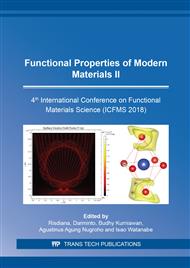[1]
N. Ratman, Geology Map Indonesia Sheet Surabaya 2nd Edition, Bandung, Center for Geological Research and Development, (1988).
Google Scholar
[2]
F. Rozi, A. Budiman, Effect of Temperature Variation Against Iron Magnetic Mineral Grass Form, J. Fisika Unand 4 (2) (2015) 123-128.
Google Scholar
[3]
J. Jumaida, W. Wahyu, E. Mukhtar, Effect of Sintering Temperature on Structure and Magnetic Properties of Mn-Zn Ferit Material, Prosiding Pertemuan Ilmiah XXVIII HFI Jateng & DIY, Yogyakarta, 26 April 2014. ISSN: 0853-0823.
Google Scholar
[4]
Afdal, L. Niarti, Characterization of Magnet Properties and Mineral content of Iron River of Batang Kuranji River of West Sumatra, J. Ilmu Fisika 5 (1) (2013) 24-30.
DOI: 10.25077/jif.5.1.24-30.2013
Google Scholar
[5]
Ratnawulan, Characterization of Natural Iron Ore as a Magnetite Raw Material on Dry Ink, Journal of Science and Mathematics 6 (1) (2013).
Google Scholar
[6]
A. Ibrahim, I. Yusuf, Azwar, Identification of Metal Compounds in Iron Sand in Aceh Province, Majalah Ilmiah BISSOTEK 7 (1) (2012) 44-51.
Google Scholar
[7]
Zulkarnain, Possible Utilization of Aceh Coastal Coastal Sand Sand for Magnet Fabrication, Prosiding Seminar Nasional Bahan Magnet I, Serpong, 11 Oktober 2000, ISSN 1411-7630, (2000) 59-61.
Google Scholar
[8]
Z. Jalil, E.N. Sari, Ismail, E. Handoko, Study of Phase Composition and Magnetic Properties of Aceh Coastal Sandy Coastal Sand Sewage by Mechanical Milling Method, Indonesian Journal of Applied Physics 4 (1) (2014) 110-114.
Google Scholar
[9]
D. L. Kartika, S. Pratapa, Synthesis of Fe2O3 from Iron Sand with Metal Dissolved Method of Chloride Acid, J. Sains dan Seni Pomits 3 (2) (2014) 33 –35.
Google Scholar
[10]
Sholihah, F.R., Zainuri, M., Effect of Holding Time Calcination on the Magnetic Properties of Barium M-hexaferrite (BaFe12-xZnxO19) with Ion Doping Zn, ITS Science and Art Journal 1 (1) (2012) 25-29.
Google Scholar
[11]
R. L. Sari, Mashuri, Epoxy-Fe3O4 Composite As a Radar Wave Absorbent Material at Frequency8-12.4 GHz. digilib.its.ac.id/public/ITS-paper-31846-1109100050-paper.pdf. (2010).
Google Scholar
[12]
Susilawati, A. Doyan, H. Khair, M Taufik, Wahyudi, Electrical, Magnetic and Microwave Absorption Properties of M-type Barium Hexaferrites (BaFe12-2xCoxNixO19), IOP Conf. Series: Journal of Physics: Conf. Series 1011 (2018) 012009.
DOI: 10.1088/1742-6596/1011/1/012009
Google Scholar
[13]
I. N.Saidah, M. Zainuri, Effect of pH Variation of HCl Solvent on Barium Synthesis M-Hexaferrite With Doping Zn (BaFe11, 4Zn0,6O19) Using Coprecipitation Method, Jurnal Sains dan Seni ITS 1 (1) ( 2012) 41-46.
Google Scholar
[14]
D. A. Vinnik, D. A. Zherebtsov, L. S. Mashkovtseva, S. Nemrava, M. Bischoff, N. S.Perov, R. Niewa, Growth, Structural and Magnetic Characterization of Al-Substituted Barium Hexaferrite Single Crystals, Journal of Alloys and Compounds 615 (2014)1043-1046.
DOI: 10.1016/j.jallcom.2014.07.126
Google Scholar
[15]
H. Sözeri, H. Deligöz, H. Kavas, A. Baykal, Magnetic, Dielectric and Microwave Properties of M–Ti Substituted Barium Hexaferrites (M = Mn2+, Co2+, Cu2+, Ni2+, Zn2+), Ceramics International 40 (6) (2014) 8645-8657.
DOI: 10.1016/j.ceramint.2014.01.082
Google Scholar
[16]
R. Agustianto, W. Widyastuti, Mol Fraction And Ph Variation Against Magnetic Properties And Micro Barium Structure With Hexaferrite Sol-Gel Method Auto Combustion, Jurnal Teknik ITS 3 (1) (2014) 108-112.
Google Scholar
[17]
Susilawati, A. Doyan, S. Sahlam, Synthesis and Characterization Materials M-Barium Hexaferrite Doping Ions Co-Mn Nano Particle, IOP Conf. Series: Materials Science and Engineering 196 (2017) 012016.
DOI: 10.1088/1757-899x/196/1/012016
Google Scholar
[18]
J. Li, H. Zhang, V. G. Harris, Y. Liao, Y. Liu, Ni–Ti equiatomic co-substitution of hexagonal M type Ba(NiTi)xFe12−2x O19 ferrites, Journal of Alloys and Compounds 649 (2015) 782- 787.
DOI: 10.1016/j.jallcom.2015.07.173
Google Scholar
[19]
S. H. Mahmood, A. N. Aloqaily, Y. Maswadeh, A. Awadallah, I. Bsoul, M. Awawdeh, H. Juwhari, Effects of Heat Treatment on the Phase Evolution, Structural, and Magnetic Properties of Mo-Zn Doped M-type hexaferrite, In Solid State Phenomena, 232 Trans Tech Publications, (2015) 65-92.
DOI: 10.4028/www.scientific.net/ssp.232.65
Google Scholar
[20]
R. Agustianto, W. Widyastuti, Mol Fraction and Ph Variation Against Magnetic Properties And Micro Barium Structure With Hexaferrite Sol-Gel Method Auto Combustion, Jurnal Teknik ITS, 3(1) (2014) 108-112.
Google Scholar
[21]
N. Dawar, M.Chitkara, I. S. Sandhu, J. S. Jolly, S. Malhotra, Structural, Magnetic and Dielectric Properties of Pure and Nickel-Doped Barium Nano Hexaferrites Synthesized Using Chemical Coprecipitation Technique, Cogent Physics 3(1) (2016) 1208450.
DOI: 10.1080/23311940.2016.1208450
Google Scholar
[22]
K. Velmurugan, V. S. K. Venkatachalapathy, S. Sendhilnathan, Synthesis of Nickel Zinc Iron Nanoparticles by Coprecipitation Technique, Materials Research 13 (3) (2010) 299-303.
DOI: 10.1590/s1516-14392010000300005
Google Scholar
[23]
H. Sözeri, H. Deligöz, H. Kavas, A. Baykal, Magnetic, Dielectric and Microwave Properties of M–Ti Substituted Barium Hexaferrites (M= Mn2+, Co2+, Cu2+, Ni2+, Zn2+), Ceramics International 40 (6) (2014) 8645-8657.
DOI: 10.1016/j.ceramint.2014.01.082
Google Scholar


